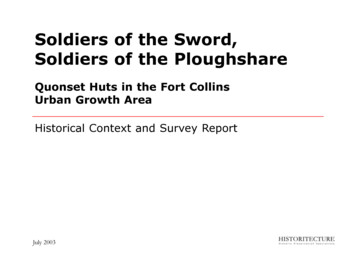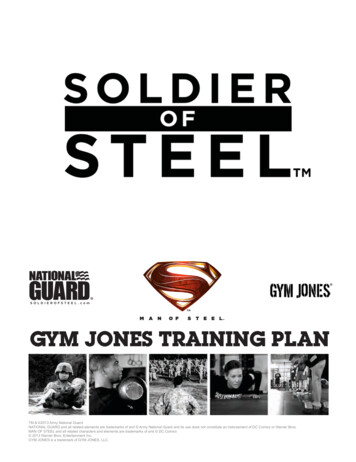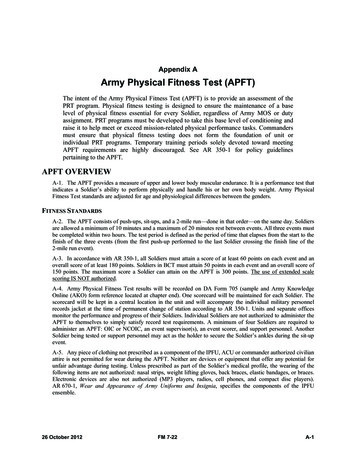
Transcription
Soldiers of the Sword,Soldiers of the PloughshareQuonset Huts in the Fort CollinsUrban Growth AreaHistorical Context and Survey ReportJuly 2003
Soldiers of the Sword,Soldiers of the PloughshareQuonset Hutsin the Fort Collins Urban Growth AreaHistorical Context and Survey ReportSubmitted to:Advance Planning Department,City of Fort Collins, Larimer County, ColoradoSubmitted by:Adam Thomas,Principal HistorianHISTORITECTURE, L.L.C.Post Office Box 419Estes Park, Colorado 80517www.historitecture.comJuly 2003
ContentsFigures, Maps, and TablesIntroduction An Inverse Relationship 1Section I: Historical ContextChapter 1 Architectural Heritage of the Quonset Hut 4Definitions 4Barrel-Roof Forms 4Metal Buildings 5Chapter 2 Soldiers of the Sword: Quonset Huts in World War II 7Chapter 3 Soldiers of the Ploughshare: Quonset Huts in Fort Collins 12Quonset Huts at CSU 12Other Quonset Huts 17Conclusion 20Section II: Reconnaissance Survey ReportChapter 4 Definitions and Methodology 22Project Area 22Methodology 22Typology 23Chapter 5 Summary of Findings 28Fig. 1Fig. 2Fig. 3Fig. 4Fig. 5Fig. 6Fig 7Fig 8Fig. 9Fig. 10Fig. 11Fig. 12Fig. 13Fig. 14Fig. 15Fig. 16Fig. 17Fig. 18Fig. 19GI Joe to College Joe 1Christman Field Hangar 41923 Sugar Beet Shanty 5Shanty at 209 Third Street 5Stran-Steel Nail Groove 6Interior of 20-by-40-foot Quonset 840-by-100-foot Quonset 9Stran-Steel Quonset Hut Models 10Interior structural support system 11Montgomery Ward half Quonset 13Half Quonsets at Veterans’ Village 14Full Quonsets, Veterans’ Village 15Quonset dormitories 16Green Hall and Veteran’s Village 17Wood-frame Quonset, Lesser Drive 18Gambles Store advertisement 18Quonset Hut, 416 Jefferson 19Two-thirds Quonset, 287 North 19Grain-silo Quonset garage 20Map 1Map 2Location Map (North) 26Location Map (South) 27Table 1 Quonset Hut Profiles 25Chapter 6 Survey Results 30Notes 42Bibliography 45Quonset huts line the northeast side of JeffersonStreet in Fort Collins. (Photo by the author)HISTORITECTURE, L.L.C.ii
IntroductionAn Inverse Relationship“Soldiers of the Ploughshare as well as Soldiers of the Sword.”— John Ruskin,“Qui Judicatis Terram,” Unto This Last, 1862In 1944-45, as Allied forces battled to victory in Europeand the Pacific, American politicians and business leaderswere less than elated. The end of World War I in 1919had taught them a painful lesson; the return of soldiers tothe private sector and retooling of industry for peacetimecreated a severe economic depression and sparked bitter,violent labor disputes. Moreover, the current war hadhelped the nation emerge from the Great Depression ofthe 1930s. With memories of bread lines and Hoovervillesfresh in their minds, Americans home and abroad desiredto preserve their wartime prosperity. But victory wouldmean the return of 12 million troops and the elimination of millions of jobs in defense plants. Thus, in 1944,President Franklin Roosevelt submitted to Congress whathe termed “a second Bill of Rights,” in preparation for thereturn of American soldiers to their homeland. The legislation, officially termed the “Servicemen’s ReadjustmentAct” but better known as the “G.I. Bill,” guaranteed newveterans the right to employment, housing, food, clothing,recreation, medical care, and education.1One of the most immediate and profound impactsof the G.I. Bill was on colleges and universities. The laweffectively democratized higher education in the UnitedStates. With generous government grants and loans, aveteran could easily afford to become the first memberof his family to obtain a college degree, regardless of hisrace, ethnicity, or financial ability. For each enrolled G.I.,the federal government paid tuition and fees directly tothe university and provided a 50 to 75 monthly stipenddirectly to the student. But colleges and universities werevastly ill-prepared for the onslaught. Student populations atmost universities had remained stagnate or even declinedfrom 1941 to ‘45. Moreover, the war had halted construction of new classroom and housing facilities. After 1945,some campuses faced student populations that dwarfedprewar and wartime numbers. In 1939, the total populationof students enrolled in degree-granting programs in theUnited States was 1.3 million and remained steady throughthe war years. In 1946, that number exploded to 2 million,and, by the peak year of veteran enrollment in 1949, thestudent population numbered around 2.5 million.2Thus, at the conclusion of World War II, the UnitedStates military and the nation’s colleges and universitiesentered into a strange inverse relationship. As the armedforces mustered out millions of men, they also soughtto dispose of an immense surplus of equipment. And asveterans enrolled in colleges and universities, those institutions found themselves with equally immense shortages ofinstructors, equipment, supplies and, most acutely, classrooms and housing. Moreover, many of the veterans weremarried with children on the way or already toddling about.Traditional single-sex dormitories simply could not housethese new veteran-students.But the problems this inverse relationship created1Figure 1. The end of World War II and the opportunities of the G.I. Bill quickly and profoundly alteredthe lives of returning servicemen. The caption reads“One year ago today, VE Day, the Yank began histransformation from GI JOE to COLLEGE JOE.”(Rocky Mountain Collegian, May 8, 1946)
Soldiers of the Sword, Soldiers of the Ploughshare: Quonset Huts in the Fort Collins Urban Growth Areawere solved in large part by one the most unique Americanbuilding forms ever created – the Quonset hut. During thewar, these corrugated metal, half cylinders had quicklyremedied the military’s vast housing and storage deficiencies. Now they would do the same at universities. Thesetubular swords were forged anew into ploughshares. By thelate 1940s, the Quonset hut was as ubiquitous on Americancollege campuses as the column-lined library or stately oakHISTORITECTURE, L.L.C.and elm trees. From there, it found itself in downtowncommercial districts, residential neighborhoods, industrialparks, and farms. And Fort Collins was no exception. Formore than half a century, these graceful arcs of steel andwood have left an indelible impression upon the city’s builtenvironment.2
Section IHistorical Context
Chapter 1Architectural Heritage of the Quonset HutDefinitionsAccording to American Architecture: An IllustratedEncyclopedia, a Quonset hut is “[a] prefabricated structure that has a semicylindrical shape; commonly constructed of corrugated steel fastened to arched steel ribsthat are attached to a concrete slab floor.”3 In a trueQuonset hut, the walls and roof are the same, seamlesscomponent; generally the curve of the roof begins at thefloor. However, some Quonset huts feature short, vertical knee walls, which generally do not exceeded 4 feet inheight. These short walls can be seamless – formed intothe exterior cladding or structural support system – or areseparate components, often extensions of the concretefoundation. Because the vertical wall can only represent afraction of the overall side elevation, this criteria excludesairplane hangars and other barrel-roof, metal-frame buildings. Moreover, similar shaped, reinforced concrete structures are generally not considered Quonset huts. For thepurposes of this context, semicylindrical green houses,whether with glass or plastic glazing, are not includedbecause of their specific function, lack of metal cladding,and differences in structural support members. However,some former Quonset huts may have been converted intogreenhouses. An analysis of these structures would requirean examination of the support system and footprint. Thiscontext does, however, include wood-frame Quonset-likestructures because of their historical relationship to themetal form.Barrel-Roof FormsQuonset huts share a common heritage with bothhigh-style and vernacular curved-roof, rectangular-planHISTORITECTURE, L.L.C.structures dating to Roman antiquity in Europe, Asia,and Africa, and to prehistoric times in North America.The most basic component of the Quonset hut – its verystructural essence – is the arch, an architectural innovation perfected by the ancient Romans and an icon of theirculture. The arch allowed Romans to span great distanceswith heavy masonry construction. When arches wereplaced behind each other in a row, they formed an arcade.The resulting ceiling structure was a barrel vault, which isa masonry canopy of semicylindrical cross sections supported by parallel walls. Most commonly employed in thenaves of Romanesque cathedrals and other monumentalstructures, the barrel vault allowed masonry builders toincorporate vast amounts of space beneath a single roof.4Barrel-roof structures also evolved early amongthe native peoples of North America. Native Americantribes in what is now the northeast United States oftenconstructed dwellings with arched roofs. These structuresboasted a wood frame of light poles or branches fastenedwith leather cords. The curved roof supports were merelysaplings or some other limber branch held in tensionbetween the sides of the vertical frame. Like the corrugated metal sheets of the classic Quonset hut, the exteriorwall cladding of these longhouses was not load bearing.These coverings, which like the modern Quonset did notvary from wall to roof, included bark, thatch, woven matsof vegetable fiber, or less frequently, tanned animal hides.The Ute People constructed similar structures, referred toas wickiups, on Colorado’s western slope. Upon the introduction of the horse in North America, these structureswere replaced with teepees, which were far more easy totransport.54Figure 2. While similar in its roofline and exteriorcladding to a true Quonset hut, this airplane hangardiffers in that vertical walls comprise most of theside elevations. It is located at Christman Field, onCSU’s Foothills Campus. (Photo by the author)
Soldiers of the Sword, Soldiers of the Ploughshare: Quonset Huts in the Fort Collins Urban Growth AreaAmerica’s English colonies along the Atlantic seaboard also developed a convex roof form, referred toas a compass or compass-headed roof. This structureconsisted of actual curved rafters, as in Quonset huts, orof a complex system of rafters and perlins forming a semicylindrical shape – the bow-string truss. Colonists rarelybuilt residential structures with this roof form, reserving itpredominately for early commercial structures, particularlywarehouses.6A more local curved-roof vernacular form emergedwith the boom in Colorado’s sugar beet industry. Like theQuonset hut, these structures were prefabricated to quicklyremedy a housing shortage. Shortly after the region’s firstsugar refinery opened in Loveland, large numbers ofGermans, who had originally settled in the Volga Riverregion of Russia, arrived in Larimer County. In the springof 1902, special trains, sponsored by the sugar companies, brought hundreds of Volga German families fromNebraska and Kansas to northern Colorado. Like the boomin the veteran-student population a half century later, sugarbeet growers and producers scrambled to find housing fortheir workers. During the first few beet campaigns, thesefamilies often lived in tents, boxcars, or granaries, chickencoops, and other farm structures converted into housing.Quickly, however, local beet sugar manufacturers and farmers provided prefabricated, barrel-roofed shanties. By lateDecember 1902, Fort Collins’s Buckingham neighborhoodboasted thirteen of these houses, which measured 20-by12 feet, with four small, square windows. The curved roofeliminated the amount of lumber necessary to construct agabled or hipped roof, but provided enough curvature torepel rain and melting snow.7 Inside, most shanties wereone or two rooms, a rather ancient hall-and-parlor divisionof corporate space. Larger, more permanent shanties contained an actual division between rooms, while suspendedblankets divided sleeping from living and cooking areasof smaller structures. These shanties appear to have beenHISTORITECTURE, L.L.C.moved from place to place and served function to function, just like modern Quonset huts.8Metal BuildingsThe history of mass-marketed and mass-producedmetal buildings parallels a boom in American industry. Asfortune-seekers converged on California gold fields in thelate 1840s, Peter Naylor, a New-York-state metal roofer,sensed an opportunity. He devised a small structure ofinterlocking iron panels. The structures were easy toassemble, more comfortable than a canvas tent and, unlikewood shanties, were fireproof. Touted in advertisements as“portable iron houses for California,” the structures provedquite popular with prospectors and miners; at the height ofthe gold rush in 1849, Naylor sold between 500 and 600units. Similar structures also appeared at Colorado’s minesand boomtowns. More often, however, these buildingsfeatured wood frames covered in corrugated sheets of tin,a precedent of the Quonset hut’s structural and claddingsystems.9Black gold created yet another rush demanding cheap,easily assembled metal buildings. In 1901, oil was discovered near Beaumont, Texas. Almost overnight, oil derrickscovered the landscape, and beside nearly each of themwas a new kind of prefabricated building featuring a metalframe with a corrugated metal skin. This kind of storagestructure and equipment housing proliferated with theexplosion of automobile ownership in the United States,particularly after Henry Ford introduced his very affordable Model T in 1908. In two years, Ford sold 500,000of the automobiles, creating a huge demand for garages.Soon, advertisements for prefabricated, gable-roofed metalstructures, with simple steel frames and sheets of corrugated metal, appeared in the popular press and could bemail ordered trough the Sears Roebuck & Company andMontgomery Ward catalogs. In 1916, these structures usually cost between 50 and 75.105Figures 3 and 4. Round-roof sugar beet workers’ shanties became a familiar site on the edgesof northern Colorado’s farm fields and GermanRussian settlements. Above is a photograph of aWeld or Larimer county sugar beet shanty circa1923. Below is a similar shanty, with an attachedshed-roof addition along the left side, at 209 ThirdStreet in Fort Collins’s Buckingham Neighborhood.(Top photo from U.S. Department of Labor; bottomphoto by the author)
Soldiers of the Sword, Soldiers of the Ploughshare: Quonset Huts in the Fort Collins Urban Growth AreaPre-engineered metal buildings continued to evolvethrough the 1920s and ‘30s. The maturation of the airplane through this period demanded even larger structuresfor hangars. During the 1933-34 World’s Fair in Chicago,heralded as the “Century of Progress,” an Armco exhibition introduced a standing seam metal roof, in which thesupport structure and cladding were the same material.Standing seams were interlocking, water-proof junctionsbetween two sheets of metal, created by turning up theedges of adjacent sheets and then folding them overtogether. This design would later influence post-WorldWar II Quonset huts and dominate those models manufactured today.11Another building exhibit at the same World’s Fairintroduced an innovation that had an even more profoundeffect on the future development of the Quonset hut.The Stran-Steel Company, a division of Great Lakes SteelCorporation, worked with Good Housekeeping magazineHISTORITECTURE, L.L.C.to develop a low-cost, fireproof, prefabricated house. Thestructure was constructed of a steel frame clad with bakediron enamel panels. The most notable feature, however,solved one of the biggest shortcomings of metal-framebuildings: attaching exterior and interior wall cladding.Before the Good Housekeeping Stran-Steel house, attaching anything to a steel structure involved elaborate systemsthat hindered the efficiency of the buildings for light commercial or domestic use. To solve the problem, Stran-Steeldeveloped a nailing groove for this demonstration house.This innovation allowed exterior wall cladding or interior wall finishes – what the company termed “collateralmaterial” – to be nailed directly into the steel supportingmember. Thus, installing a corrugated metal exterior or awallboard interior was as easy as pounding a nail into astud.126Figure 5. Stran-Steel nail groove. This innovation allowed the builder to install exterior andinterior wall cladding by simply nailing it directlyinto the steel support structure. (Great Lakes SteelCorporation, Stran-Steel Division)
Chapter 2Soldiers of the Sword: Quonset Huts in World War IIThe American buildup for World War II began evenbefore the Japanese bombed Pearl Harbor on December7, 1941. But military preparations had to come quickly.The horrors of World War I left Americans steadfastlyisolationist. Throughout the 1920s and ‘30s, Congressand the President consistently advocated a policy thatremoved the United States from foreign affairs, includingthe Senate’s rejection of U.S. membership in the League ofNations’ World Court, and the passage of the NeutralityActs. Throughout this period, the American militarywaned. But as Japanese power increased in the Pacificand Hitler’s army battled across Europe, Americans realized that war was inevitable. After all, the massive Nazimilitary machine had conquered Western Europe in just70 days. As German soldiers and tanks occupied Paris,horrified leaders in Washington leapt from their isolation.In 1940-41, Congress agreed to lend or lease war materialto Great Britain, the Soviet Union, and their allies; to enactthe nation’s first peacetime draft; and to triple the WarDepartment’s budget.13With greatly increased funding, the branches of theU.S. Armed Forces initiated a colossal war preparationeffort. For the Navy, a particularly pressing problem wasa lack of facilities; it needed quickly deployable structuresfor housing, storage, headquarters, and an array of otherpurposes. In the late winter and early spring of 1941,Rear Admiral Ben Morell, chief of the Navy’s Bureau ofYards and Docks, began considering the force’s paucityof buildings. Morell know that the British had developeda semicylindrical, prefabricated structure during WorldWar I. Termed the Nissan hut, it was the kind of building Morell envisioned for the U.S. Navy. But it had twoHISTORITECTURE, L.L.C.major problems: first, there was no easy way to attachsheet-metal cladding to the frame, and second, it simplytook up too much precious shipping space. Producing apractical structure would require some advanced pre-engineering. Thus, in March, Morell approached the GeorgeA. Fuller Construction Company, of New York City, andStran-Steel, a division of the Great Lake Steel Corporation,with a challenge: design a hurricane-resistant, prefabricatedbuilding that could be quickly assembled by untrained men,shipped in small containers, and be used for any one of 48purposes, including galleys, shower-latrines, dental offices,isolation wards, and even bakeries. And Morell gave theFuller–Stran-Steel team only 60 days to complete the task.The companies did not hesitate to accept, sending a groupof engineers and metalworkers, headed by Peter Dejonghand assisted by Otto Brandenberger, to the Navy yards atQuonset Point, Rhode Island. This place would soon lendits Native-American name to the structures designed andcreated there.14Stran-Steel was an obvious choice to develop a structure to the Navy’s specifications. The company had beenengaged in the light construction industry for more thana decade before the outbreak of World War II. In addition to the nail groove, Stran-Steel had already developedmethods to nest its building materials, reducing the unassembled size of its structures and, ultimately, the shippingcost. Thus, the company had already solved the Navy’s twomajor problems with the Nissan hut.15On the other hand, the Fuller Company and Dejonghappeared at first glance to be the least likely candidatesfor designing and constructing a Quonset hut. Fuller wasamong the preeminent builders of large-scale construc7What’s in a name?According to a Great Lakes Steel Corporation,Stran Steel Division document, the Navy originally referred to the semi-cylindrical structuresdeveloped at Quonset Point, Rhode Island, as theStran-Steel Arch Rib Hut. Stran-Steel, however,borrowed the place name Quonset to differentiatethese structures from its other lines of prefabricated buildings. Soon Quonset became common parlance among military personnel and quickly reachedthe civilian population. Technically, “Quonset hut”is an official trademark of the Great Lakes SteelCorporation and is registered in the United StatesPatent Office.Source: Great Lakes Steel Corporation, Stran-Steel Division
Soldiers of the Sword, Soldiers of the Ploughshare: Quonset Huts in the Fort Collins Urban Growth Areation projects, particularly skyscrapers. Peter Dejongh wasborn in the Netherlands and graduated with a degree inengineering from the University of Delft. He joined theFuller company in 1924. But this union of a huge construction company and a European-trained engineer was,upon second glace, the best choice to design a small, simplestructure to the Navy’s demanding specifications. After all,beginning in the 1920s, the construction of a skyscraper– or of any large building for that matter – required a steelskeleton. Fuller’s engineers and workmen had an intimate,working knowledge of steel construction and its largescale prefabrication. They had personally experienced themetal’s capabilities and limits.16Moreover, Dejongh’s training at Delft was undoubtedly influenced by the work and philosophy of theBauhaus movement in Germany. World War I left theEuropean continent in ruins and an entire generationdisillusioned. On the battlefield, traditional methods ofwarfare clashed with a new technology of destruction; theresult was unprecedented massacre. As distrust of “oldways” grew, designers in Germany sparked a movementto reject the past and all falsity of historicist architecture.At the end of the war in 1919, Walter Gropius establishedthe Bauhaus School of Architecture. Inspired by the day’ssocialist thinkers, instructors and students believed beautycame from function and the uninhibited display of modernmaterials: steel, glass, and reinforced concrete. Membersof the Bauhaus reveled in the use of a repetitive intervalbetween members of a building’s framework, creatingpurely geometric forms. They sought to design spaces thatwere rational, efficient, and inexpensive – machines forliving. “Functionalism, emphasizing how a building servedits inhabitants, was of prime importance,” write Virginiaand Lee McAlester in their architectural guidebook.“Traditional elements that were merely decorative, ratherthan functional, were to be discarded.”17 (Following thewar, Dejongh served as construction engineer for many ofHISTORITECTURE, L.L.C.the icons of International and Miesan architecture, including the Seagram, Union Carbide, and Exxon buildings inManhattan and I.M. Pei’s Mile High Center in Denver, thatcity’s first modern skyscraper.) Bauhaus philosophy wouldprove extremely valuable in creating the Quonset hut. Withits ability to house many uses, its purely geometric form,and its lack of any ornament, the structure was, after all,the epitome of the Bauhaus movement.18The first Quonset hut that the Fuller–Stran-Steelteam created manifested the companies’ experiences insteel work and, through Dejongh, the influence of theBauhaus. Completed from concept to prototype in only 30days, the original Quonset hut measured 16 feet wide by 36feet long. The arch-rib steel members, 8 feet in radius, wereT-shaped, measuring 2 inches by 2 inches by a 1/4 inch.Perpendicular to these ribs were attached wood perlins,8Figure 6. The interior view of a 20-by-48-foot,war-surplus Quonset reveals the original arch-ribdesign Dejongh developed at Quonset Point, exceptthat the original perlins are steel rather than wood.Colorado A&M (CSU) first acquired this particularQuonset for veteran-student housing. It is nowlocated at the Swetsville Zoo, 4801 East HarmonyRoad. (Photo by the author)
Soldiers of the Sword, Soldiers of the Ploughshare: Quonset Huts in the Fort Collins Urban Growth Areawhich anchored the corrugated steel sheet exterior cladding. Most connections were made with standard-sized,self-tapping screws. The prototype featured pressed-woodinterior lining, insulation, and a tongue-and-groove woodfloor.19Dejongh and his Fuller–Stan-Steel team redesignedand improved the Quonset hut throughout the war, evenas they continued production at the Quonset Point facility. Engineers from the University of Michigan and theUniversity of Detroit oversaw product proving, includinggrueling wind-tunnel tests. One of the biggest problemsoccurred when the team tried to modify the function – andthus interior space – of the building. Each of the 48 usesrequired individual drawings. Moreover, equipment, fromovens to beds, had to be redesigned and custom built tofit the curved, side walls. And Navy officials, adamantthat every square foot count, lamented that the junctionof the curved wall and the floor created unusable space; itreduced the effective width of the structure. In response,Dejongh and the Fuller–Stran-Steel team created a newstructural support member. Measuring 2 inches by 3 5/8inches, it consisted of two, lightweight steel U-shapedchannels welded back to back. The channels hosted apreviously developed Stran-Steel nail groove. But the mostnotable feature of these new supports was their shape;instead of the pure, semi-circle of the original T-shapedarch-ribs, these new supports left the floor at a 90-degreeangle and continued vertically for four feet, at which pointthey arched over to form a barrel roof. This created a shortvertical wall, eliminating the unusable space of the originalQuonset hut. Simply termed “Quonset redesigned hut,”these structures measured 16 feet wide by 36 feet long;plans for the various functions of the original Quonsetswere redrawn to accommodate the new form.20As the war continued, Dejongh and the Fuller–StranSteel team remained at Quonset Point, constantly refiningits design and increasing its uses. They addressed detailsHISTORITECTURE, L.L.C.and problems as workers assembled each model at theproving grounds. The Navy had particular interest inthe test assembly of each building because it determinedthe practicality of the structure for field use. In all, theNavy approved 86 different interior layouts for the smallQuonset huts and a 40-by-100-foot warehouse model.21Further redesigns were necessary when it came toshipping the structures to various theaters of war. Becauseof increasingly cramped holds in its ships, the Navydemanded the lowest tonnage and shipping space possiblefor each structure. The original models weighed 4 tons andassumed 450 cubic feet of space. The Fuller–Stran-Steelteam decided to use lighter-gauge corrugated, galvanizedsteel sheets and half-inch plywood floors rather than the 1inch tongue-and-groove floor of the prototype. They alsodetermined that the true semicylindrical Quonset, despiteits interior space deficiencies, was actually lighter than thosewith the four-foot vertical wall. The resulting modificationallowed an increase in the size of the assembled structureto 20 by 48 feet but reduced each unit to 3 1/2 tons and 325cubic feet of shipping space. Amazingly, these Quonsethuts required less shipping space than did tents with woodfloors and frames but could accommodate the same number of men – a testament to the skill of Dejongh and hisproduction facility at Quonset Point.22Other, more minor modifications were also madeduring the war. Originally, the structures were shippedwith unpainted corrugated, galvanized steel sheets. Thissemi-reflective cladding, however, presented the risk onbeing spotted by enemy aircraft. Thus, Stran-Steel beganto apply olive-drab camouflage paint at the factory. Onelast modification came in 1943 – the same year the Navyhanded over all Quonset hut manufacturing to Stran-Steel– when the ends of hut were continued another four-feetover the bulkhead, providing protection from driving rainsand direct sunlight. While the length of the structuresincreased to 56 feet, the interior living space remained at 489The Military Build-UpNumbers of Fuller–Stran-Steel Quonset Hutsdesigned and built for the Navy.T-rib QuonsetQuonset RedesignedQuonset 20-by-48 (and 56)Warehouse Type ce: Department of NavyFigure 7. This Stran-Steel, 40-by-100-foot warehouse-type Quonset hut is currently located onColorado State University’s main campus, north ofWest Lake Street on the Burlington Northern SantaFe railroad. (Photo by the author)
Soldiers of the Sword, Soldiers of the Ploughshare: Quonset Huts in the Fort Collins Urban Growth Areafeet. However, in the spring of 1945, the Navy determinedthat the overhangs were unnecessary in colder, northern climates. As a result, the remaining 56-foot versionsbecame distinctive tropical Quonset huts.23Fuller, Stran-Steel, and the Navy also designed andbuilt larger models of the Quonset hut for use in establishing advance bases. At first, the Navy used 40-by-100foot prefabricated metal buildings with vertical sides and acurved roof. However, they were heavy and required a largeamount of shipping space. The team at Quonset Pointthen created a semicylindrical hut of the same dimensions.It reduced the shipping weight from 20 to 12 1/2 tons ofsteel and required only 350 cubic feet of space rather than650. The Fuller team also designed multi-arch supports,which combined several 40-by-100-foot structures into asingle warehouse under one roof. One of these multipleunit Quonset huts in Guam created a 54,000-square-footwarehouse.24For soldiers and sailors living and working in Quonsethuts, the buildings provided a s
blankets divided sleeping from living and cooking areas of smaller structures. These shanties appear to have been moved from place to place and served function to func-tion, just like modern Quonset huts.8 Metal Buildings The history of mass-marketed and mass-produced metal buildings parallels a boom in American industry. AsFile Size: 1MB










